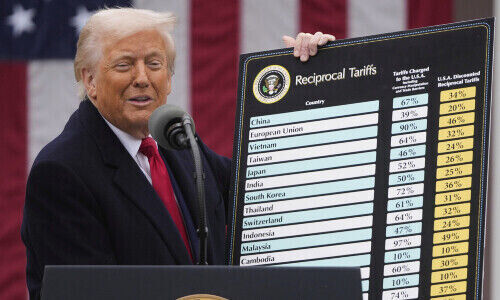Trump 2.0’s 100-Day Report Card Disappoints
The first three months of a new administration are traditionally viewed as a milestone for evaluating early accomplishments. While the 100-day mark of President Trump’s second term officially falls next week on April 30, the verdict is already in—and it’s sobering.
«President Trump’s current term is the only one in which the S&P 500, Dow Jones, and the FTSE World Index have all declined in the first 100 days,» wrote global asset manager Aberdeen in a commentary.
Using comparisons with incoming US administrations since Bill Clinton in 1993, Aberdeen notes that as of April 21, 2025, the S&P 500 had dropped by 891,04 points (14.7 percent), the Dow Jones fell by 5,855.39 points (13 percent), and the FTSE World Index lost 102,22 points (9.75 percent).
Although the S&P 500 and FTSE World Index also declined under George W. Bush in his first 100 days, the Dow Jones did not—and the drops were significantly less severe.
The other four presidents (Bill Clinton, Barack Obama, Donald Trump in 2017, and Joe Biden) all posted gains in all three markets during their first 100 days, Aberdeen highlights.
«When government policy and markets collide, it’s often investors who suffer. While volatile markets can present long-term buying opportunities for patient, contrarian investors, they also bring substantial short-term uncertainty,» says Aberdeen manager Ben Ritchie.
Stagflationary Shock
Initially, markets had hoped that Trump’s presidency would unleash US entrepreneurial energy through tax relief and deregulation, according to Paul Diggle, Chief Economist at the British asset manager.
But sentiment has since turned. «Trump is implementing his announced tariff policy – and even going beyond it. Even if we assume tariffs will eventually decline again, uncertainty remains high. These tariffs and the political ambiguity are acting as a stagflationary shock to the US economy – slower growth combined with higher inflation—and that is now being reflected in equity prices,» he said.
As a result, Aberdeen notes that a fundamental reassessment of the attractiveness of US assets is underway. This affects stocks, bonds, and the US dollar.
Structural Capital Outflows from US Assets
The US has enjoyed a unique position for over a decade, outperforming globally and attracting significant capital. «But stocks and the dollar are still overvalued, even after recent declines,» Diggle adds.
One possible scenario is that Trump softens his stance on tariffs, making US companies more attractive again. Another possibility: high valuations, slowing growth, and ongoing political uncertainty lead to a structural capital outflow from US assets.
Political Reality Clashes with Expectations
Allianz Global Investors also delivers a cautious verdict on the first 100 days. The political reality, they say, is clashing with the high expectations Trump himself fueled. «While he sticks to his ideas, their implementation will likely be slow,» they note.
That includes market-friendly core elements of «Trumponomics» such as tax reform and infrastructure investment, where congressional support will be crucial.
«Trump’s promise of sustained economic growth of 3 to 4 percent will be hard to achieve and primarily depends on employment and productivity gains,» the commentary continues. «If Trump can cut back regulation, the financial sector is likely to benefit more than the energy sector. Overall, progress is likely to be slower than expected.»



























